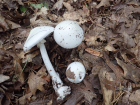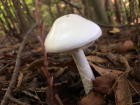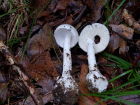Cap egg-shaped to convex to somewhat flattened. Surface smooth and white, sometimes with a pale tan- or cream-coloured tint in the center. The surface is either dry or slightly sticky when the environment is moist. The flesh is thin and white, and does not change colour when bruised. The margin of the cap is rolled inwards in young specimens. Gills white and crowded closely together. They are either free from attachment to the stipe or just barely reach it. Stem thick, solid and tapers slightly upward. The surface, in young specimens especially, is frequently fibrillose (covered with small slender fibers), or squamulose (covered with small scales). The bulb at the base of the stipe is spherical or nearly so. The delicate ring on the upper part of the stipe is a remnant of the partial veil that extends from the cap margin to the stalk and covers the gills during development. It is white, thin, membranous, and hangs like a skirt. Spore print white.
Microscopic Features: The spores measure 7-10 µm in length and 6-9 µm in width. They have a smooth surface and are globose to subglobose or very broadly ellipsoid in shape. Additionally, they exhibit amyloid staining.
Amanita bisporigera on the MushroomExpert.Com Web site.
Amanita bisporigera on the NC State Partners Web site.
The first and third photo is by Huafang and licensed under the Creative Commons Attribution 3.0 Unported license.
Many mushrooms are poisonous, and some can be lethally toxic. Distinguishing between edible and poisonous mushrooms can be very challenging. Therefore, we strongly advise against consuming wild mushrooms. This website does not contain any information about the edibility or toxicity of mushrooms.
Although efforts have been made to ensure accuracy on this website, the information may contain errors and omissions. Therefore, all content provided is for educational and informational purposes only and should not be relied upon or used as a basis for consuming any plants or mushrooms.
External links are provided for reference only. We do not endorse or take responsibility for the content, advice, or products found on these sites or in any advertisements shown on this website.


